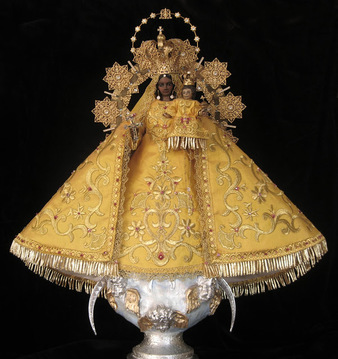Why Is It Called Santería?

The Virgin of Charity La Caridad del Cobre Patroness of Cuba
Most practitioners of Santería prefer the name Regla de Ocha or the Lucumí religion. Although it's practiced today by people all over the world, Regla de Ocha is generally defined as an Afro-Cuban religion that originated in what is today Nigeria and Benin in West Africa. The word Santería comes from Spanish and loosely translates as devotion to the saints, or santos. Many practitioners of the Regla Lucumi refer to the Orichas, or the deities of the religion, as saints or "santos." This tendency to combine terminology and concepts from Catholicism and West African religions is sometimes called religious syncretism.
Where Does Santería Come From?

Dancer representing Ochún
Santería has its roots in the Yoruba people of West Africa. The slave trade brought many Africans to Cuba, Brazil, Haiti, the southern USA, Puerto Rico, Trinidad and other Caribbean basin nations. In Cuba, the slaves of Yoruba origin were called "Lucumí," perhaps due to the mistaken belief that they all belonged to the Ulkumí tribe, or because the slaves addressed each other as Oluku Mi, meaning "my friend."
Although most Africans were forced to convert to Catholicism upon arrival in the New World, many continued to practice their native religions at the same time. A common misconception is that Afro-Cubans blended the two religions into a single one, but a more accurate way to think about religious syncretism in Cuba is to say that the two systems continued parallel to each other in the minds of the Afro-Cuban people, who didn't see any contradiction between them. Practitioners of Regla de Ocha or Santería might describe themselves as Catholic, attend Catholic masses, and baptize their children as Catholic, while also practicing their African-based religion in their ilé, or Lucumí temple-house, in their own homes or in the home of a religious elder. While they know that the Catholic saints and the Lucumí Orichas are not identical, they find similarities between them, and they see no problem keeping a statue of Saint Barbara or the Virgen of Charity on a Lucumí altar, as another way of representing Changó or Oshún, two of the most popular Orichas in Cuba. For centuries, Santería was practiced as a somewhat "secret" religion as a way to avoid religious persecution or the negative social stigma attached to Afro-Cuban culture in general. It survived as an oral tradition, passed down from one generation to another, through initiation ceremonies that created a tightly bound community and distinct lineages based on ancestors. As Cubans left the island, many took their religion with them, and Santería spread to the United States, Canada, Europe, and other South American countries.
Although most Africans were forced to convert to Catholicism upon arrival in the New World, many continued to practice their native religions at the same time. A common misconception is that Afro-Cubans blended the two religions into a single one, but a more accurate way to think about religious syncretism in Cuba is to say that the two systems continued parallel to each other in the minds of the Afro-Cuban people, who didn't see any contradiction between them. Practitioners of Regla de Ocha or Santería might describe themselves as Catholic, attend Catholic masses, and baptize their children as Catholic, while also practicing their African-based religion in their ilé, or Lucumí temple-house, in their own homes or in the home of a religious elder. While they know that the Catholic saints and the Lucumí Orichas are not identical, they find similarities between them, and they see no problem keeping a statue of Saint Barbara or the Virgen of Charity on a Lucumí altar, as another way of representing Changó or Oshún, two of the most popular Orichas in Cuba. For centuries, Santería was practiced as a somewhat "secret" religion as a way to avoid religious persecution or the negative social stigma attached to Afro-Cuban culture in general. It survived as an oral tradition, passed down from one generation to another, through initiation ceremonies that created a tightly bound community and distinct lineages based on ancestors. As Cubans left the island, many took their religion with them, and Santería spread to the United States, Canada, Europe, and other South American countries.
